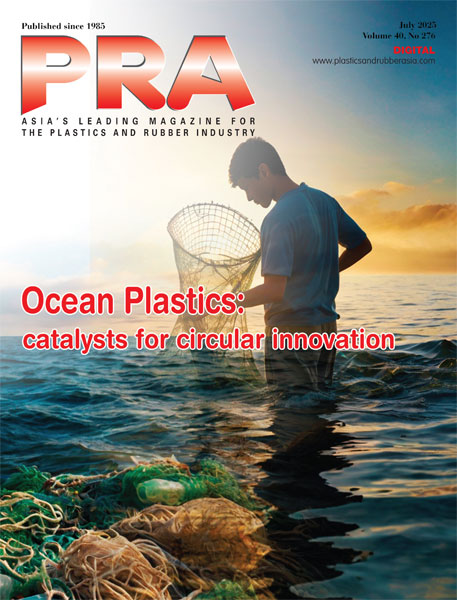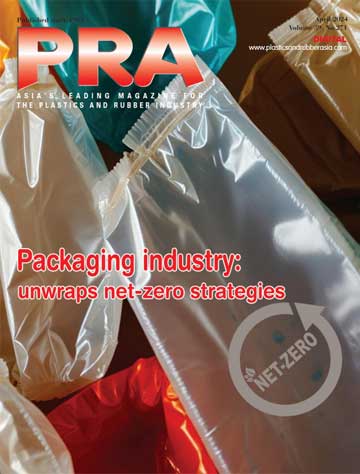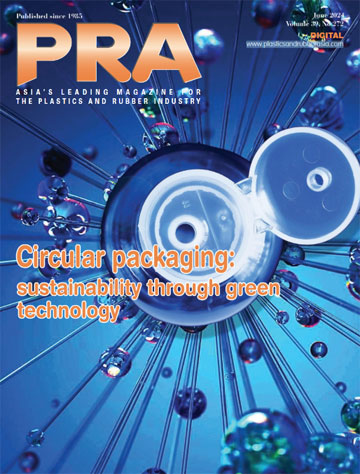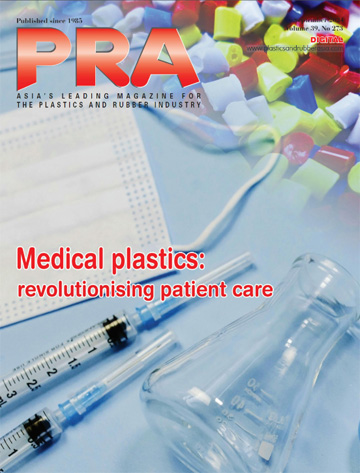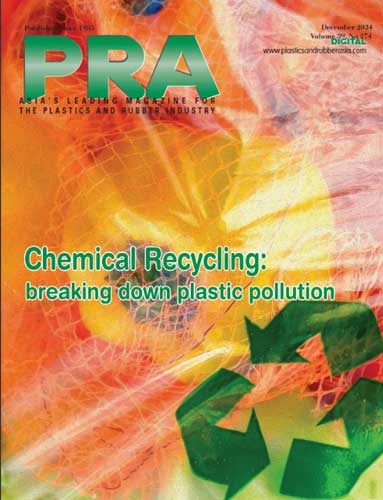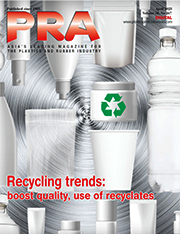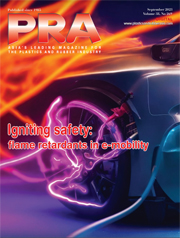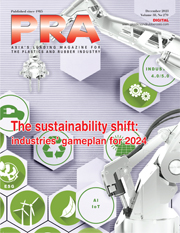K2025: Materials
Bio-based/biodegradable
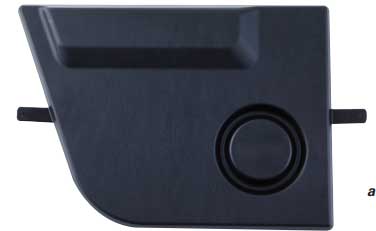
Japan’s Asahi Kasei will display PA and SEBS compounds utilising a bio-based and biodegradable cellulose nanofibre (CNF), made from cotton linter. CNF-reinforced SEBS features softness, has low warpage and shrinkage, and good hydrolysis resistance, making it suitable for jigs & tooling or prosthetics & orthotics devices. As well, Asahi Kasei has developed PFAS-free low-friction Leona PA and will introduce a new grade, said to feature same lowfriction properties as fluororesins, making it suitable for sliding applications in automotive, robot parts, OA parts, and sporting goods.
Engineering plastics major Polyplastics Group will unveil its latest advances in Durafide polyphenylene sulphide (PPS) and the development of bio-based p-hydroxybenzoic acid (PHBA), a key monomer for liquid crystal polymer (LCP). It is also focusing on PBT-to-PBT solvent-based recycling, which can segregate glass-reinforced PC/PBT into its GF, PC, and PBT constituents, thus allowing recyclability of waste PBT-based compounds. Another development of POM-toPOM chemical recycling facilitates 100% re-generation to engineering plastics and is currently in demo phase with a targeted launch in 2028.
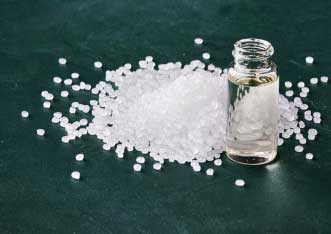
Danish specialty materials manufacturer Palsgaard will highlight its Einar 987, a vegetable oil-based anti-fouling additive designed as a drop-in replacement for ethoxylated amines for PP/PE polymerisation processes. The product is food-contact approved, effective at low dosage levels (100–300 ppm), and delivers the same reactor efficiency and product quality while eliminating toxic legacies. It offers resin makers an alternative solution that aligns with anticipated changes in chemical safety requirements.
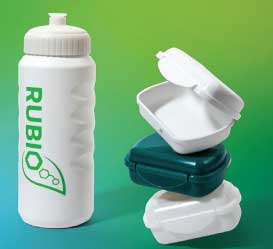
Fraunhofer IAP has produced 20 new types of polybutylene succinate (PBS) and scaled from the lab stage to a 100-kg scale, with 3 tonnes of PBS already produced. Melt stability of the materials has been improved with temperature stability of over 200°C. Together with industry partners Sauer GmbH and Gramß GmbH it produced a sports water bottle and cap, using blow/injection moulding. It adds that PBS can be processed under real conditions efficiently and with mechanical properties.

Germany’s BASF at K2022 introduced its LowPCF and ZeroPCF portfolios, to reduce the Product Carbon Footprint (PCF) by a minimum of 30%, through the use of renewable electricity, low-emission steam and renewable raw materials, in a mass balance approach. A current example is Vaude’s bike bag using Ultramid PA6 ZeroPCF, said to be the first in the industry to achieve a CO2 footprint of net zero. Building on this, BASF has now launched an improved reduced PCF product range, rPCF, for its engineering plastics and TPUs.
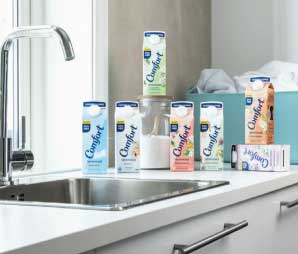
US materials firm Dow will showcase D-Pak cartons produced in collaboration with Elopak and Orkla Home and Personal Care (OHPC), which offer a mix of rPE and biocircular (renewable) polymers. In the consumer sector, Dow will be showcasing its collaboration with Guerlain, utilising Surlyn Ren Ionomers for La Petite Robe Noir perfume caps, while in the wire and cables sector, it will highlight its Revoloop recycled resins (using PCR material) for cable jackets.
Packaging
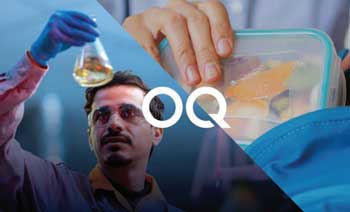
OQ, Oman’s energy group, has introduced 17 new polymer grades over the past year including six PP impact copolymers for rigid packaging such as thinwall packaging, housewares and durables, offering flow and stiffness-impact balance; four PP random copolymers with enhanced transparency and organoleptic performance for housewares, closures, and food containers. Furthermore, it also introduced PE graded, including a rotomoulding grade (Luban LL-8446.21), developed for water storage and road safety applications delivering impact, durability and UV resistance.
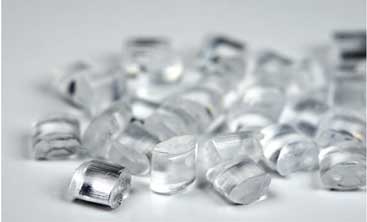
With stricter EU rules under the Packaging and Packaging Waste Regulation (PPWR), Ineos Styrolution, on the other hand, has launched its latest circular packaging breakthrough: sour cream cups made with 30% rPS, in collaboration with development partner Aldi and Unternehmensgruppe Theo Müller, scaling sustainable food packaging for mass-market use. It has also commercialised its 100% bio-attributed Styrolution PS ECO 158K BC100, with food trays using this bio-based PS made available on the shelves of the Japanese market through collaboration with a well-known retail franchise.

US materials firm ExxonMobil will highlight solutions, many of which were created in collaboration with machine manufacturers, converters, and brand owners.
These include mono-material PE solutions designed for recyclability and/or downgauging opportunities, such as MDO cereal pouches from Colines, freezer pouches from W&H, silo bags from Armando Alvarez, pet food bags from Bandera, and vacuum skin cheese packaging from Alpine.
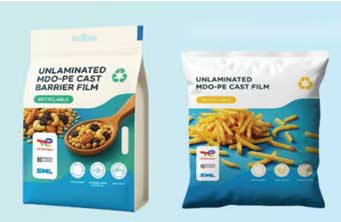 Other solutions incorporating PCR content include cast stretch film from Erema, block bottom valve bags from Selene, compression packaging from Optima, high tenacity stretch film from W&H, stretch hood films from Reifenhauser, and silage covers from RaniPlast. it will also bring product samples and film rolls to the show, including its monomaterial PE solutions designed for recyclability, solutions incorporating PCR content, and the Exxtend technology for advanced recycling.
Other solutions incorporating PCR content include cast stretch film from Erema, block bottom valve bags from Selene, compression packaging from Optima, high tenacity stretch film from W&H, stretch hood films from Reifenhauser, and silage covers from RaniPlast. it will also bring product samples and film rolls to the show, including its monomaterial PE solutions designed for recyclability, solutions incorporating PCR content, and the Exxtend technology for advanced recycling.
Recycling/Sustainability
Asahi Kasei’s recycling technology enables the recovery of continuous carbon fibres from carbon-fibre-reinforced plastic (CFRP) pressure vessels used in automobiles. Utilising electrolysed sulphuric acid, the process completely decomposes the resin matrix while preserving the carbon fibres' original strength and continuous structure.
At K, it will show over 200 m of recycled continuous carbon fibre.
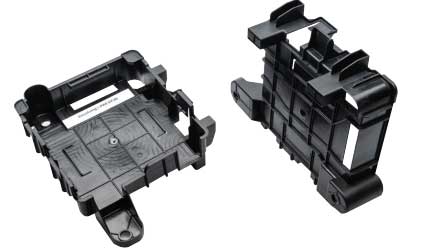
PA supplier Domo Chemicals’s pilot project, with Audi AG and Fraunhofer Institute, will show PA6/PA66-based parts moulded using 30% PCR materials from end-of-life vehicles, meeting OEM requirements. It will also present ISCC Plus certified-Domamid MBB, a mass-balanced, bioattributed PA6 with up to 69% bio-attributed content.
Meanwhile, BASF, in collaboration with machine firms Krauss Maffei, Rampf and Liebherr, is developing a chemical recycling process to return PU to the same material cycle. In the depolymerisation process, recycled polyols are produced, which can be used to manufacture new PU rigid foams as insulation material in refrigerators.

German compatriot materials firm Covestro is also developing chemical recycling of PU mattress foam, under the Evocycle CQ brand. This pilot contributes to a broader “Circular Foam” collaboration involving 22 partners, with the goal of recycling 1 million tonnes of PU foam and saving 2.9 million tonnes of CO2/year by 2040.
Elsewhere, to counter challenges of plastic waste in hospitals, Saudi Arabia’s Sabic says it has worked with two hospitals in Belgium and Netherlands, by demonstrating the feasibility of recycling used medical plastic back into the medical materials stream. Converted to pyrolysis oil in an advanced recycling process, it delivered circular feedstock for Sabic’s production of Trucircle polymers in medical-grade quality with the same performance, purity and physiological safety as virgin-based medical-grade polymers, it adds.
Another company involved in recycling is chemical firm LyondellBasell. Its proprietary MoReTec (molecular recycling technology) advanced recycling technology, being built at its Cologne hub in Germany by 2026, will enable it to convert post-consumer plastic waste into feedstock for the production of new polymers. The pyrolysis oil and pyrolysis gas from the process can be used as a feedstock for new plastic materials under the CirculenRevive brand for use in a range of applications, including medical and food packaging.
Flame-retardant materials

Germany’s KRAIBURG TPE will focus on two new FC/CM3/ AD1 series compounds that comply with both the European Regulation (EU) No. 10/2011 and the US FDA. These were specifically developed for TPE applications with contact to fatty foods or cosmetics. In addition to their processability in multi-component injection moulding, the compounds offer properties such as a pleasant feel and robustness.
Another product highlight will be compounds from the FR3 series, or the third generation TPEs with improved flame retardancy, meeting all requirements of the European standard for railroad applications DIN EN 45545-2 R22 HL3 and R23 HL3. These materials have properties that make them ideal for fire protection applications, including PP adhesion and processing in standard injection moulding and extrusion processes.
Meanwhile, Spain’s Tolsa will highlight its range of Adins flame-retardant additives, which have emerged as a halogen-free and antimony trioxide (ATO) free replacement for a range of matrices including PVC, PA, PP, PE and rubber. Adins products not only replace ATO but also improve flame retardant properties across multiple axes, including smoke suppression, anti-dripping, and heat release reduction. This fire enhancement enables customers to not just substitute but upgrade the fire performance of their material in a sustainable way, adds Tosla.
(PRA)SUBSCRIBE to Get the Latest Updates from PRA Click Here»


